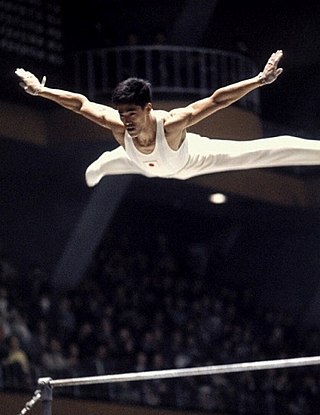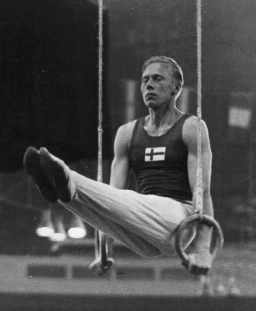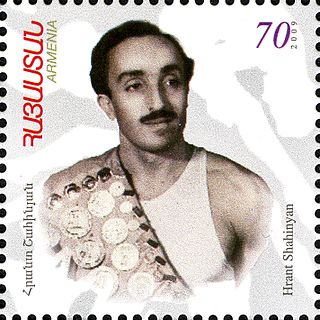
The men's vault was a gymnastics event contested as part of the Gymnastics at the 1964 Summer Olympics programme at the Tokyo Metropolitan Gymnasium. The event was held on 18, 20, and 23 October. There were 130 competitors from 30 nations, with nations in the team competition having up to 6 gymnasts and other nations entering up to 3 gymnasts. For the first time in three Games, there was a clear winner with no tie. Haruhiro Yamashita took the gold medal, the second consecutive gold for Japan. Victor Lisitsky finished second, taking silver but breaking the Soviet Union's three-Games gold medal streak. Hannu Rantakari's bronze was Finland's first medal in the event since 1948.

The men's parallel bars was a gymnastics event contested as part of the Gymnastics at the 1964 Summer Olympics programme at the Tokyo Metropolitan Gymnasium. The event was held on 18, 20, and 23 October. There were 128 competitors from 29 nations, with nations in the team competition having up to 6 gymnasts and other nations entering up to 3 gymnasts. The event was won by Yukio Endo of Japan, the nation's first victory in the parallel bars after two Games with silver and bronze medals. It was the first of a four-Games gold medal streak for Japanese gymnasts in the event. Japan also took silver, with Shuji Tsurumi finishing second. Bronze went to Franco Menichelli of Italy.

The men's horizontal bar was a gymnastics event contested as part of the Gymnastics at the 1964 Summer Olympics programme at the Tokyo Metropolitan Gymnasium. The event was held on 18, 20, and 23 October. There were 128 competitors from 29 nations, with nations in the team competition having up to 6 gymnasts and other nations entering up to 3 gymnasts. The event was won by Boris Shakhlin of the Soviet Union, the nation's first victory in the horizontal bar after two Games with silver and bronze medals. The Soviets also took silver, with Yuri Titov finishing second. Shakhlin and Titov were the fifth and sixth men to win multiple medals in the horizontal bar. Bronze went to Miroslav Cerar of Yugoslavia.
These are the results of the men's floor competition, one of eight events for male competitors in artistic gymnastics at the 1960 Summer Olympics in Rome.
These are the results of the women's floor competition, one of six events for female competitors in artistic gymnastics at the 1960 Summer Olympics in Rome.
These are the results of the men's team all-around competition, one of eight events for male competitors in artistic gymnastics at the 1960 Summer Olympics in Rome.
The men's artistic team all-around competition at the 1948 Summer Olympics was held at Earls Court Exhibition Centre. It was held on 12 and 13 August, and was the ninth appearance of the event.
The men's artistic team all-around competition at the 1952 Summer Olympics was held at the Messuhalli, Exhibition Hall I on 19 and 21 July. It was the tenth appearance of the event.
The women's artistic team all-around competition at the 1952 Summer Olympics was held at Messuhalli, Exhibition Hall II on 22–24 July. It was the fourth appearance of the event.

The men's artistic individual all-around competition at the 1948 Summer Olympics was held at Earls Court Exhibition Centre on 12 and 13 August. It was the tenth appearance of the event. There were 123 competitors from 16 nations, with each nation sending a team of up to 8 gymnasts. The event was won by Veikko Huhtanen of Finland, the nation's first victory in the men's all-around. Finland also earned bronze, with Paavo Aaltonen finishing third. For the second consecutive Games, Switzerland took silver—this time with Walter Lehmann as the nation's medalist.

The men's artistic individual all-around competition at the 1952 Summer Olympics was held at Messuhalli, Exhibition Hall I from 19 to 21 July. It was the eleventh appearance of the event. There were 185 competitors from 29 nations. Each nation entered a team of between five and eight gymnasts or up to three individual gymnasts. The event was won by Viktor Chukarin of the Soviet Union, with his countryman Hrant Shahinyan taking silver. It was the Soviet debut in the event, beginning four decades of dominance rivalled only by Japan and ending after the dissolution of the Soviet Union; the Soviets would win 6 of the 10 editions from 1952 to 1988, with Japan taking the other 4. Bronze in 1952 went to Josef Stalder of Switzerland ; it was the last medal in the men's all-around for any gymnast not from the Soviet Union or Japan until 1980.

The men's vault competition at the 1948 Summer Olympics was held at Earls Court Exhibition Centre on 12 and 13 August. It was the seventh appearance of the event. There were 120 competitors from 16 nations, with each nation sending a team of up to 8 gymnasts. The event was won by Paavo Aaltonen of Finland with fellow Finn Olavi Rove finishing second; the medals were the nation's first in the men's vault. There was a three-way tie for third place resulting in three bronze medals being awarded to János Mogyorósi-Klencs and Ferenc Pataki of Hungary and Leo Sotorník of Czechoslovakia.

The men's pommel horse competition at the 1948 Summer Olympics was held at Earls Court Exhibition Centre on 12 and 13 August. It was the seventh appearance of the event. There were 121 competitors from 16 nations, with each nation sending a team of up to 8 gymnasts. The event ended in a three-way tie for the gold medal, with all three winners from Finland: Paavo Aaltonen, Veikko Huhtanen, and Heikki Savolainen. It was the third time the medals had been swept in the event. Another three-way tie would occur in 1988. It was Finland's first victory in the event, and first medal since 1928.

The men's rings competition at the 1948 Summer Olympics was held at Earls Court Exhibition Centre on 12 and 13 August. It was the seventh appearance of the event. There were 121 competitors from 16 nations, with each nation sending a team of up to 8 gymnasts. The event was won by Karl Frei of Switzerland, with his countryman Michael Reusch earning silver; they were the nation's first medals in the event. Zdeněk Růžička of Czechoslovakia took bronze.

The men's horizontal bar competition at the 1948 Summer Olympics was held at Earls Court Exhibition Centre on 12 and 13 August. It was the seventh appearance of the event. There were 121 competitors from 16 nations, with each nation sending a team of up to 8 gymnasts. The event was won by Josef Stalder of Switzerland, with his countryman Walter Lehmann taking silver. It was the nation's second victory in the event, tying the United States for most all-time. Veikko Huhtanen of Finland earned bronze, giving Finland a three-Games podium streak in the event.

The men's parallel bars competition at the 1948 Summer Olympics was held at Earls Court Exhibition Centre on 12 and 13 August. It was the seventh appearance of the event. There were 122 competitors from 16 nations, with each nation sending a team of up to 8 gymnasts. The event was won by Michael Reusch of Switzerland, with his countrymen Christian Kipfer and Josef Stalder tying for bronze. Between the Swiss gymnasts was Veikko Huhtanen of Finland, taking silver. Reusch was the first man to win multiple medals in the event ; Stalder would become the second in 1952. It was Switzerland's second victory in the event, tying Germany for most gold medals.
The men's floor exercise competition at the 1952 Summer Olympics was held at Messuhalli, Exhibition Hall I from 19 to 21 July. It was the fourth appearance of the event.
The men's artistic team all-around competition at the 1956 Summer Olympics was held at the West Melbourne Stadium from 3 to 7 December. It was the eleventh appearance of the event.
The women's artistic team all-around competition, one of six events for female competitors in artistic gymnastics at the 1960 Summer Olympics in Rome, was held at the Baths of Caracalla from 6 to 8 September. It was the 6th appearance of the event.
These are the results of the men's team all-around competition, one of eight events for male competitors in artistic gymnastics at the 1968 Summer Olympics in Mexico City.






